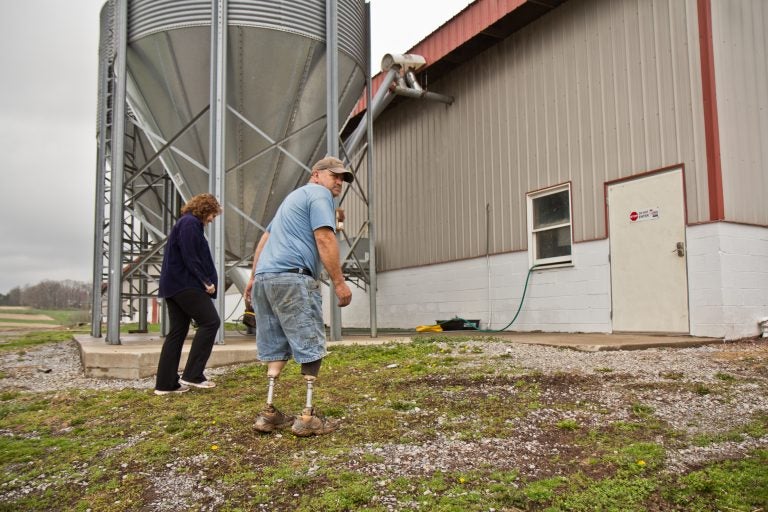Staying mobile to keep farming
As American farmers grow older, many more people may experience mobility issues — and need the adaptive technology disabled farmer Dennis Hunsberger uses.
Listen 3:31
Dennis Hunsberger and his wife Lori at the chicken house on his farm. (Kimberly Paynter/WHYY)
Twenty years ago, farmer Dennis Hunsberger came down with bacterial meningitis. One day he was feeling fine, and the next he fell into a coma. He didn’t regain consciousness for three weeks.
Hunsberger eventually recovered, but poor circulation can be a lingering side effect of the illness, and the skin on his heels died, leading to severe ulcers. By late 2016, the sores had infected the bone, and he needed surgery to remove both feet.
Even facing this serious operation, farming was on Hunsberger’s mind.

“He said he was determined to get back on that tractor by spring to start planting,” says his wife, Lori. “And if you want to see a determined man, this is him right here.” She smiles down at her husband, who’s resting in a chair beside her.
First Dennis was in a wheelchair, then he got two prostheses that reach almost up to each knee. Eventually, he moved to a walker and then a cane.
“He often lost the cane — ‘Oh where did I leave that?’” Lori remembers, laughing.
It took a few months to get back to work, but he did it.
“I pretty well do everything that I did before, when I had my both feet,” Dennis says.
Lori and Dennis farm 500 acres and raise over a hundred thousand chickens in central Pennsylvania. Even while Dennis was still re-learning how to walk, the farm needed his attention.
“We had a cable break in the chicken house, and I climbed a 5-foot step ladder within two months of having these feet on, because I needed to fix that cable to get the ventilation right in the chicken house,” he says.
Eventually, Dennis connected with AgrAbility, a nationwide group that supports farmers with disabilities. They got him funding for some tweaks to his equipment. For instance, Dennis drives a huge truck that carries corn between his fields and the mill. The load has to be covered with a tarp in case of wind or rain.
“I used to have to crawl along the side of the truck to strap it down,” he explains. “Now, we made it so that I just have to hit a button and it tarps it.”
Dennis hauls himself into the front seat a little unsteadily and hits the button. The tarp quickly unrolls across the massive truck bed, like a convertible top for corn passengers.

His bright green John Deere tractor is also modified. It’s from the 1970s and only comes with one step up to the seat. For Dennis, getting inside is like trying to get on a school bus with no stairs.
“It’s a whole lot harder with just the one step,” he says, breathing hard. “It’s a lot more energy and it’s not as safe for me, since I don’t have the mobility I used to have.”
Dennis got two extra steps put in, and it made a huge difference. Some things still give him trouble, though — it’s hard not being able to feel where his feet are, and he sometimes loses his balance. That happened recently when Dennis was laying drain pipe with a neighbor.
“I was still walking around there, and I got off the loader, the backhoe, and fell down because of the mud and the tall weeds there,” he says, laughing. “Got me mixed up in my feet. But I got back up again, so …”
The average age of farmers in the United States has increased in recent decades, from about 51 years to 58 years. As American farmers grow older, more people may experience mobility issues and need the adaptive technology Dennis Hunsberger uses.
WHYY is your source for fact-based, in-depth journalism and information. As a nonprofit organization, we rely on financial support from readers like you. Please give today.










